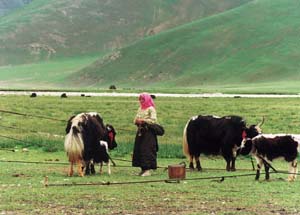Meteorologists say moisture has become a luxury in Lhasa, capital city of Tibet Autonomous Region, as hygrometers have registered record low humidity since October.

The dry autumn weather has also caused many Tibetans to wake up to nosebleeds in the morning.
According to the Lhasa observatory, the average daily "relative humidity," the water vapor percentage in the air at a certain temperature, has stood at around 10 percent since last month when most of the country's southern provinces experienced rainfall.
As it stands, there is little water component in the air in the "Sunlight City" which sits at 3,700 meters above sea level, making the weather "extremely dry" and things "flammable," says the observatory.
Experts attributed the desiccation to a weak cold air front from the north and poor moisture conditions around the Indian Peninsula and the Bay of Bengal in the south.
Rainfall in most parts of Tibet last month was more than half of normal years. In some of southwestern areas of the Autonomous Region, no precipitation was reported for the entire month, experts said. Locals and visitors alike were recommended to drink abundant amounts of water and apply efficient sun cream.
Tibet's average October temperature in most parts of the plateau region was one to three degrees Celsius higher than normal years.
Meteorologists, however, expected the region's temperatures to drop three to four degrees in some places this week with rainfall and snow in some places.
Tibet, with its glaciers and high altitude, is regarded as a region sensitive to the effects of global warming.
Its average annual temperature is rising at a rate of 0.3 degree Celsius every 10 years, higher than the growth rate of the rest of China and the world, according to recent research.
(Xinhua News Agency November 6, 2007)






